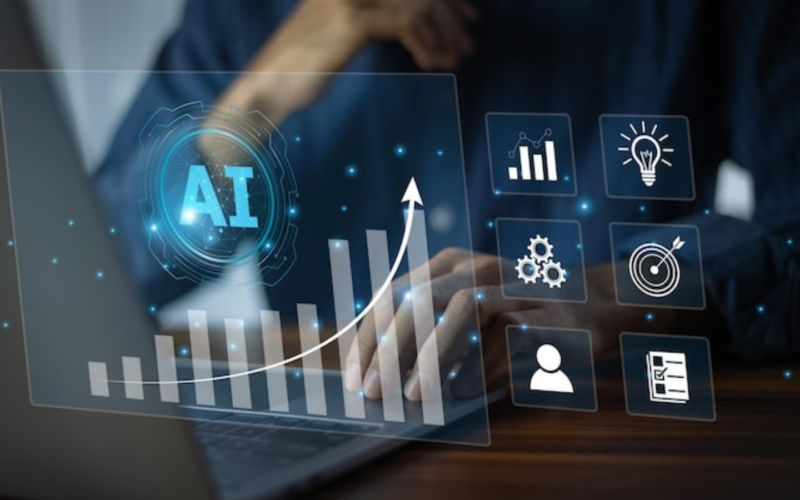Do you find it challenging to turn enterprise analytics AI from a buzzword into a measurable driver of growth? Many enterprises invest heavily in data and AI initiatives, yet struggle to convert insights into action, align teams, and demonstrate ROI.
The opportunity is massive. The global data analytics market size is expected to reach USD 658.64 billion by 2034, growing at a CAGR of 29.40%. This growth demonstrates that organizations utilizing enterprise analytics and AI effectively can gain a significant advantage in decision-making, operational efficiency, and customer experience.
In this comprehensive guide, you’ll learn how combining enterprise analytics with AI can help detect operational bottlenecks and forecast demand shifts. It can personalize customer engagement and automate high-value decisions. Together, these capabilities can turn complex datasets into real-time actions that boost profitability and strategic impact.
Key Takeaways
- Enterprise analytics + AI = strategic advantage: Combining both enables you to integrate cross-departmental data, uncover hidden patterns, and generate insights that traditional analytics would miss.
- Four analytics types form the foundation: Descriptive, diagnostic, predictive, and prescriptive analytics work together to deliver a complete decision-making framework.
- AI transforms analytics into action: Machine learning, NLP, and agent-based systems turn raw data into forecasts, recommendations, and automated execution.
- Role-specific value creation: From product managers to executives, AI-powered analytics delivers custom insights that improve retention, efficiency, and strategic planning.
- Adoption needs governance: Data quality, scalability, literacy, and privacy safeguards are critical to achieving reliable, enterprise-wide AI analytics outcomes.
What Is Enterprise Analytics?
Enterprise analytics is the practice of analyzing data from all areas of an organization to make informed decisions, improve performance, and gain a competitive edge.
Unlike departmental analytics, which focuses on isolated functions, enterprise analytics takes a unified view by integrating data from sales, operations, marketing, finance, and other areas. This connected approach allows you to identify patterns and opportunities that would remain hidden in silos.
In practical terms, enterprise analytics combines big data technologies with statistical and predictive modelling techniques to make sense of vast, complex data sets. The process involves collecting structured and unstructured data, cleaning and organizing it, and then applying analytical models to uncover actionable insights.
With the help of these insights, you can refine strategies, optimize processes, and respond to market changes with greater speed and accuracy.
Example: For a healthcare provider, enterprise analytics can combine patient records, treatment outcomes, staffing data, and supply chain information into a single analytical framework. This can help spot trends in patient care, predict equipment needs, and allocate resources more efficiently, thus improving both patient outcomes and operational efficiency.
However, before you can put enterprise analytics to work, it helps to understand the different types available and how each one will shape your decisions.
Types of Enterprise Analytics
Large enterprises typically employ four main types of analytics, each serving a distinct role in transforming raw data into strategic action. When applied together, they form a complete decision-making framework.
1. Descriptive Analytics: What Happened?
This is the foundation of enterprise analytics, focusing on past events and trends. It uses reports, dashboards, and data visualization to summarize historical performance.
Example: A retail chain can review the previous quarter’s sales dashboard to identify which product lines have performed the strongest.
2. Diagnostic Analytics: Why It Happened?
This type of analytics investigates the causes behind specific outcomes. Techniques such as drill-down analysis, data mining, and correlation studies help identify the root causes of the issue.
Example: A logistics company will analyze delivery delays to determine whether driver shortages, route inefficiencies, or supplier bottlenecks are the cause.
Why It Matters: With the help of diagnostic analytics, you will be able to address systemic issues directly, rather than repeatedly solving surface-level problems.
3. Predictive Analytics: What Might Happen Next?
Predictive analytics uses statistical models, AI, and machine learning to forecast likely outcomes. It identifies patterns and assigns probability scores to potential scenarios.
Example: A healthcare network will forecast patient admission rates during flu season to prepare staff schedules and supply orders in advance.
4. Prescriptive Analytics: What Should You Do About It?
This is the most advanced form, combining historical insights (descriptive analytics) and predictive models to recommend specific actions. It often involves simulations, optimization algorithms, and scenario planning.
Example: A fintech company will determine the optimal interest rate changes to attract new customers without reducing profit margins.
Why It Matters: With prescriptive analytics, you can shift your decision-making from a reactive to a proactive approach, enabling faster and more confident strategic moves.
Also Read: The 4 Types of Advanced Analytics Explained
Understanding the types is just the start. AI is now redefining how each one delivers value across your enterprise. Let’s explore how.
How AI Is Transforming Enterprise Analytics
AI is no longer a supporting tool in analytics. It is becoming the core engine that drives faster, smarter, and more impactful decision-making. By automating repetitive tasks, enhancing predictive accuracy, and enabling prescriptive recommendations, AI is shifting enterprise analytics from backward-looking reporting to forward-focused strategy. Here’s how:
- Faster Insights at Scale: Machine learning algorithms can process vast volumes of structured and unstructured data to detect patterns that traditional methods might miss.
- More intelligent Recommendations: Predictive and prescriptive models together can not only forecast outcomes but also recommend optimal actions to achieve business goals.
- Advanced Text Analysis: Natural language processing (NLP) can extract valuable insights from customer feedback, service logs, and other unstructured data sources. Users can also ask questions in plain English and get instant, relevant answers.
- Self-Service Dashboards: Intuitive platforms allow teams to create reports and explore data without writing code. When data becomes accessible to every department, decisions are made faster, are more informed, and are aligned with organizational goals.
- Automated Insights: Systems proactively highlight emerging trends or anomalies without requiring manual analysis.
- Conversational Analytics: Large Language Models (LLMs) allow context-aware, interactive conversations with datasets.
- Agent-Based Systems: AI agents go beyond recommendations to plan and initiate business actions.
Pro Tip: Start by automating high-volume, repeatable analytics tasks. Once those processes are streamlined, expand AI into more complex, decision-focused use cases.
Also Read: Complete Guide to Machine Learning as a Service
Understanding the technical impact of AI is crucial, but what matters most is how it affects day-to-day decision-making for various roles across your enterprise.
Role-Specific Benefits (with example)
Consider you’re a nationwide retail chain implementing an AI-powered enterprise analytics platform. Here’s how each role in your organization will benefit:
- Product Managers will gain deeper visibility into feature usage and prioritize updates that improve retention.
Example: Your PMs observe that customers are using mobile self-checkout twice as often as expected, so they expand it to more stores to boost convenience and satisfaction.
- Engineers will identify and address performance bottlenecks before they impact end users.
Example: Engineers detect a spike in page load times on your e-commerce site during peak hours and resolve the issue before it impacts conversions during a flash sale.
- Customer Support Teams will be able to detect patterns in support tickets that indicate emerging product or service issues.
Example: They notice an increase in complaints about delayed curbside pickups in specific regions and collaborate with operations to resolve the issue before it escalates.
- Marketing Teams can refine segmentation data and optimize campaigns in real time.
Example: Your marketing team notices that suburban customers respond strongly to limited-time bundle deals, allowing them to adjust the campaign mid-run for better sales.
- Executive decision-makers will monitor predictive dashboards to guide strategic decisions.
Example: You see AI forecasting higher demand for winter apparel in the Midwest, so you shift inventory early to capture the opportunity.
Also Read: AI for Data Analysis: Benefits and Future Trends
Did You Know? Role-based AI assistants can adapt insights to the user’s role, ensuring context-specific recommendations.
Why Large Enterprises Should Act Now?
The shift from static dashboards to AI-driven, action-oriented analytics is already underway. Industry leaders such as SAP, Salesforce, and Microsoft are delivering AI solutions tailored to specific industries like healthcare, finance, and manufacturing.
Without a robust data governance strategy, organizations risk falling behind as competitors adopt intelligent analytics at scale.
Pro Tip: Pair AI adoption with strong governance to ensure data accuracy, security, and compliance across all teams.
Struggling with one-size-fits-all AI tools that miss your enterprise needs? Our AI/ML Development services deliver custom analytics that forecast, recommend, and act, turning data delays into real-time advantage. Get in touch today.
Before you dive in, it’s worth examining the hurdles, because understanding the risks of AI in enterprise analytics is the first step to overcoming them.
Key Risks Involving AI in Enterprise Analytics
While there are several use cases of AI in analytics, large organizations often encounter roadblocks that can stall or weaken its impact. Recognizing these challenges early will help you design a strategy that avoids costly missteps.
1. Data Quality and Integration: AI models are only as good as the data they process. Inconsistent formats, missing values, or siloed systems can lead to inaccurate insights.
Example: If a nationwide retail chain feeds mismatched pricing data from different regions into its analytics platform, the resulting demand forecasts will be unusable.
Pro Tip: Establish a strong data governance framework with validation rules, periodic quality checks, and automated integration pipelines.
2. Data Privacy and Security: Processing customer, financial, and operational data at scale brings higher compliance risks. Regulations such as CCPA require stringent security and consent protocols.
Example: A healthcare provider using AI-powered patient analytics must encrypt data and control access to comply with HIPAA regulations.
Why It Matters: A single data breach can result in legal penalties and long-term reputational damage.
3. Data Literacy Gaps: AI-powered analytics tools are only valuable if teams can interpret and apply the insights. Lack of data literacy often slows adoption and reduces ROI.
Example: A marketing team may see a predictive churn score but fail to act effectively because they don’t understand the factors driving it.
4. Scalability and System Performance: As your data volume grows, your analytics solution must scale without performance bottlenecks. Overloaded systems can delay insights and limit responsiveness.
Example: An e-commerce platform may experience slow query responses during holiday traffic spikes, which can delay critical pricing decisions.
Pro Tip: Opt for platforms with cloud-native architecture that can scale dynamically in response to demand.
5. Organizational Resistance: Cultural resistance to new tools and processes can derail AI initiatives. Without buy-in, even the best solutions struggle to gain traction.
Example: A finance department that relies on manual spreadsheets may resist shifting to AI-driven forecasting tools.
Why It Matters: Early involvement of stakeholders and pilot projects with visible wins can help create momentum.
Knowing the risks is essential, but finding the right partner to help you overcome them is what turns potential setbacks into measurable wins.
Why Choose Codewave for Enterprise Analytics and AI
When you’re ready to turn data into a strategic advantage, Codewave brings the right mix of human-centred design, technical expertise, and long-term vision to the table. Here’s what sets us apart:
- Your Data, Your Competitive Advantage: We don’t just onboard tools. We help create a customized Data & AI strategy that becomes your technological competitive edge. That continuously evolves and mirrors your business reality, so you stay one step ahead.
- End-to-End, Design-Led Delivery: From conducting detailed data audits to creating UX-directed visualizations, we manage every stage of the process. We identify data gaps and ensure that analytics align with your strategic goals.
Furthermore, we build pipelines that extract and process the right signals, continuously monitor performance to deliver actionable insights, and integrate machine learning models to strengthen predictive capabilities.
- Experience That Scales: With more than 300 data and AI projects delivered across enterprises, governments, and VCs, we bring tested practices and deep insights to your challenge.
- Built for Tomorrow’s Technologies: Our solutions do more than report on data; they anticipate, optimize, and drive decisions automatically. From AI to NLP, we infuse next-gen intelligence into how you work.
- Designed for Impact, Curious Minds Welcome: You’re plugged into a team that listens to your business, consolidates assumptions, and co-creates solutions that deliver results and sustainably.
See our portfolio for real-world examples of how we’ve built AI-powered analytics platforms, combining multi-source enterprise data, automating reporting, and enabling predictive decision-making.
Struggling with scattered data, slow reporting, or insights that arrive too late to act? Our AI-powered Data Analytics Development service turns fragmented information into a unified, decision-ready resource.
Consult with our experts and begin building analytics systems that provide clarity when it matters most.
FAQs
1. Is AI going to take over business analytics?
AI will not replace business analysts but will augment their capabilities. It will handle data cleaning, pattern detection, and predictive modelling, enabling analysts to focus on interpreting results, advising stakeholders, and shaping data-driven business strategies.
2. What is the future of AI in enterprise analytics?
AI in enterprise analytics will increasingly integrate machine learning, generative AI, and real-time data pipelines to deliver predictive and prescriptive insights. Future platforms will automate scenario modelling, trigger process changes autonomously, and provide role-specific intelligence. This will enable enterprises to make faster, evidence-based decisions with a measurable impact.
3. How is enterprise analytics different from regular business analytics?
Enterprise analytics covers the entire organization, integrating data from multiple units to align insights with overall strategy. Unlike regular business analytics, which focuses on specific functions, it applies enterprise-wide governance and delivers intelligence for high-level strategic decision-making.
4. What are some popular enterprise analytics tools?
Common enterprise analytics tools include Google Analytics, Tableau, Power BI, Salesforce Analytics, and SAP Analytics Cloud, among others.
Codewave is a UX first design thinking & digital transformation services company, designing & engineering innovative mobile apps, cloud, & edge solutions.







